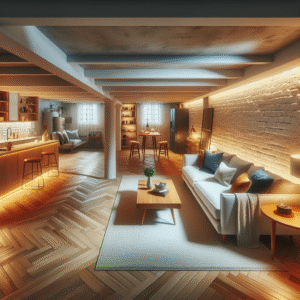Are you considering a heating upgrade that not only enhances comfort but also boosts your home’s energy efficiency? Radiant floor heating might just be what you need. This innovative heating method, unlike traditional radiators that heat the air, ensures warmth directly from the ground up. It provides an even, ambient temperature, which can transform the comfort level of your living spaces. Let’s dive into what radiant floor heating is, how it works, and explore its myriad benefits to help you decide if it’s the right investment for your home.
Understanding Radiant Floor Heating: Definitions, Types, and How It Works
Radiant floor heating is a system that supplies heat directly to the floor of a house. This type of heating comes in primarily two forms: electric and hydronic. Electric systems use electric cables or mats installed beneath the floor, while hydronic systems circulate warm water through tubing laid under the floor. The warmth from the floor then radiates throughout the room, providing a consistent and comfortable heat distribution.
Top 5 Benefits of Installing Radiant Floor Heating in Your Home
- Comfort: Enjoy evenly distributed heat, with no cold spots.
- Energy Efficient: Typically uses less energy than traditional heating systems, helping to reduce utility bills.
- Improved Air Quality: Reduces the circulation of allergens compared to forced-air systems.
- Aesthetically Pleasing: Completely hidden under floors, it doesn’t interfere with your home decor.
- Increases Home Value: A modern upgrade that can boost your property’s market value.
Cost Analysis and ROI: Is Radiant Floor Heating Worth the Investment?
While the initial setup cost for radiant floor heating can be higher than traditional heating systems, the long-term savings on energy bills and the increase in property value can make it a worthwhile investment. Additionally, the comfort and health benefits create a living environment that’s not only warm but also welcoming.
Considering radiant floor heating for your home not only provides a comfortable living environment but can also be a wise financial decision. Whether retrofitting an older home or integrating it into new construction, radiant floor heating offers a blend of luxury and practicality that few other systems can match.

If you’re ready to take your home improvement or construction project to the next level, we can help! Find trusted contractors on BuildNet, whether you’re looking for renovations, new builds, electrical work, plumbing, or anything in between. Our directory connects you with qualified professionals who can make your vision a reality.
Understanding Radiant Floor Heating: Definitions, Types, and How It Works
Hey there! If you’re considering adding a cozy touch to your home, you might want to think about radiant floor heating. This system not only warms your feet but can also enhance the overall comfort of your living space. Let’s dive into what radiant floor heating is, the various types available, and how they operate, helping you make an informed decision for your home improvements.
What is Radiant Floor Heating?
Imagine waking up on a chilly morning and stepping onto a warm and inviting floor. That’s the delight of radiant floor heating! This system provides heat directly to the floor or to panels in the wall or ceiling of a house. Unlike traditional heating systems that heat air, radiant heating warms up objects and people in the room directly. It’s like feeling the warmth of the sun indoors!
The magic of radiant floor heating lies in its ability to distribute heat uniformly and efficiently across a room. This method not only keeps your toes toasty but also maintains a comfortable ambient temperature from floor to ceiling.
Types of Radiant Floor Heating
There are mainly two types of radiant floor heating systems that you can consider for your home:
1. Electric Radiant Floors
This type features electric cables built into the floor. Systems that feature mats of electrically conductive plastic mounted on the subfloor below a floor covering such as tile are especially popular. Electric radiant heating is ideal for heating individual rooms in your house, making it a great choice for additions or renovations.
2. Hydronic Radiant Floors
These systems use heated water that flows through tubes or pipes embedded in the floor. Hydronic heating is the most cost-effective and popular method for whole-house radiant heating and can use a wide variety of energy sources to heat the water: natural gas, oil, wood, solar, or combinations of these.
How Does Radiant Floor Heating Work?
Irrespective of the type (electric or hydronic), the basic operation principle of radiant floor heating remains essentially the same. Here’s a simplified breakdown:
Installation Process
- Subfloor Preparation: The first step involves preparing the subfloor. This may include insulation to prevent heat loss downwards.
- Installing the Heating Element: Depending on the system, either electric cables or water pipes are laid down across the floor.
- Applying the Floor Surface: Over the heating elements, the final flooring material is applied—be it tile, laminate, or even hardwood.
Operation Mechanics
Once installed, the system is controlled either manually or automatically with the help of a thermostat. In electric systems, electricity warms up the cables, which in turn, heats the floor surface. In hydronic systems, a boiler heats water, which is then pumped through pipes laid underneath the floor. The heat from the pipes radiates up through the floor and spreads evenly across the room.
Why Choose Radiant Floor Heating?
The real charm of radiant floor heating lies in its inherent properties. Here’s why it could be a brilliant choice:
- Efficiency: Radiant heating is more efficient than baseboard heating and usually more efficient than forced-air heating because it eliminates duct losses. Perfect for those looking to cut down on energy bills!
- Comfort: Uniform heating creates a comfortably warm environment without the cold spots typical with other heating methods.
- Health benefits: It doesn’t distribute allergens like forced air systems can, making it healthier, especially for those with allergies.
- Quiet Operation: With no blowers or fans, radiant heating works silently, enhancing the comfort of your home.
- Design Freedom: Without the need for radiators or air vents, you have more freedom in designing your space and placing furniture.
By now, you might have a good grasp of what radiant floor heating is all about. Whether you’re renovating or building a new home, consider the comfort and efficiency of a radiant floor heating system. Feeling the gentle warmth underfoot during a cold morning can be a delightful experience, making it a worthwhile consideration for your next home improvement project!

Top 5 Benefits of Installing Radiant Floor Heating in Your Home
Have you ever stepped out of bed on a chilly morning and wished the floor felt as warm as your cozy blanket? Well, radiant floor heating might just be the game-changer you need. It’s not only a luxurious addition to your home but also an efficient one. Let’s explore the top five benefits of installing radiant floor heating in your home.
1. Unmatched Comfort
When it comes to home heating systems, the comfort provided by radiant floor heating is unparalleled. The heat originates from the floor and rises evenly across the room, eliminating the cold spots typical of traditional heating systems. Imagine walking around your home, and every step is on a gently warmed surface. It’s like the gentle warmth of a sunny day contained right in your floors!
2. Healthier Living Environment
For anyone sensitive to allergens or dust, radiant floor heating can be a blessing. This system doesn’t rely on blowing air through ducts. Traditional forced-air systems can circulate dust, pollen, and other allergens throughout your house. In contrast, radiant heating minimizes the movement of air, reducing the chance of stirring up pesky allergens. This means not only warmer feet but cleaner, healthier air in your home.
3. Energy Efficiency
Radiant floor heating is championed for its efficiency. It heats rooms from the bottom up, utilizing the natural rise of heat to warm a space evenly. By doing so, it reduces the amount of heat that escapes to unoccupied areas of the room, typically near the ceiling. Many homeowners see a decrease in their energy bills as radiant heat often requires lower temperatures to achieve the same level of warmth provided by conventional heating systems. Furthermore, when integrated with a smart thermostat, control becomes both precise and effortless, optimizing energy usage and costs.
4. Aesthetic and Design Freedom
Thinking about interior design, radiant flooring is a dream. It’s completely invisible since all components are tucked away beneath the floor. This frees up wall and floor space that would otherwise be occupied by radiators or heating vents. Whether you’re dreaming of minimalist modernism or cozy traditional rooms, radiant floor heating doesn’t just adapt; it subtly enhances by silently providing comfort. This means more freedom for placing furniture, art, and decorations without worrying about blocking heat sources.
5. Increased Home Value
If you’re considering future resale, radiant floor heating can be a significant selling point. Homes with these systems often attract buyers looking for added comfort and energy efficiency. As an investment in your property, radiant heating not only enhances current living quality but can also boost your home’s market value. It’s a feature that can truly set your property apart in competitive real estate markets.
So, whether you’re renovating or building new, radiant floor heating offers substantial benefits that go beyond simple warmth. From a healthier living environment to increased home value, the perks of installing radiant floor heating are sure to make your home a more comfortable and efficient space. Consider speaking to a local contractor who specializes in this technology to explore the best options for your home and locality. Remember, every step towards a more comfortable home is a step in the right direction!
Cost Analysis and ROI: Is Radiant Floor Heating Worth the Investment?
Hey there! If you’re toying with the idea of installing radiant floor heating in your home, you’re likely wondering about the costs and whether this upgrade is really a sound investment. Let’s break it down in simple terms so you can make a well-informed decision.
Initial Costs of Installation
First off, let’s talk numbers. The initial cost of installing radiant floor heating can vary widely depending on several factors, like the type of system (electric or hydronic), the size of the area you’re heating, and the current state of your floors. Generally, you can expect:
- Electric systems: These are typically cheaper to install, with costs ranging from $6 to $20 per square foot. They’re ideal for smaller areas like bathrooms or kitchens.
- Hydronic systems: These involve circulating hot water through pipes and are more cost-effective for whole-house heating. Installation can run between $6 and $16 per square foot but can go higher depending on complexity.
Remember, these prices are just ballpark figures. For a more accurate estimate, it’s best to get quotes from local contractors. This way, you’ll also support your local economy, which is always a good thing!
Operational Costs
Operational costs are where radiant floor heating really shines, especially if you’re considering the long-term. Here’s why:
- Efficiency: Radiant systems distribute heat more evenly and efficiently than traditional forced-air systems. This means they use less energy, which translates to lower monthly bills.
- Zoning capabilities: With radiant heating, you can easily control which areas of your home are heated and when. This targeted approach avoids wasting energy and money heating unused spaces.
Electric systems might see a slight increase in your electricity bill, but this is often offset by the system’s efficiency. Hydronic systems, on the other hand, can be connected to a variety of energy sources, some of which can be very economical like solar water heaters.
Longevity and Maintenance
Another piece of good news! Radiant floor heating systems are known for their durability and low maintenance requirements:
- Life expectancy: A well-installed radiant floor system can last up to 35 years or more, significantly longer than traditional heating systems.
- Maintenance: They require minimal upkeep. No filters to change, no ducts to clean, and with fewer moving parts, breakdowns are rare.
This longevity not only saves you money over time but also adds a layer of convenience to your home maintenance routine.
Return on Investment (ROI)
Considering the installation cost, operational savings, and longevity, the ROI of radiant floor heating is quite attractive. Homes with radiant heating often enjoy a higher market value. Here’s why:
- Energy efficiency: Today’s buyers are savvy about energy costs and environmental impact. A home with energy-efficient features is more appealing and can command a premium price.
- Comfort and luxury: The sheer comfort of stepping onto a warm floor in winter is a luxury many homebuyers will pay extra for.
The exact ROI will vary, but reports suggest that homes with radiant floor heating can see an increase in value anywhere from 3% to 5%. Plus, if you ever sell your home, this feature can be a significant selling point!
Breaking It Down: Is It Worth It?
So, should you take the plunge? If you value comfort, are looking for energy savings, and would like to potentially increase your home’s resale value, then yes, radiant floor heating is a worthwhile investment. It’s eco-friendly, efficient, and enhances the quality of life in significant ways. Plus, by hiring local professionals, you’ll be putting money back into your community, making it a win-win situation.
Ultimately, the choice is yours, but for many, the cozy allure of a warm floor on a chilly morning is just too good to pass up. Why not reach out to a local contractor and discuss your options? It might just be the best home improvement decision you’ll make!

What is Radiant Floor Heating?
Radiant floor heating is a method of warming a space by heating the floor, which then radiates heat evenly throughout the room. This system can be powered by electricity, hot water (hydronic), or air (air-heated), providing a comfortable and consistent temperature from the ground up.
How Does Radiant Floor Heating Work?
Radiant floor systems function by circulating warm water or electrical currents through tubing or cables laid beneath the floor surface. The heat rises naturally, warming objects and people in the room directly without the use of forced-air systems which can distribute allergens and dust.
What Are the Different Types of Radiant Floor Heating?
There are primarily two types of radiant floor heating systems:
- Electric Radiant Floors: These use electric cables or mats installed under the floor surface.
- Hydronic Radiant Floors: These are more cost-effective for larger areas and use water heated by a boiler that circulates through pipes embedded in the floor.
What Are the Top 5 Benefits of Radiant Floor Heating?
- Energy Efficiency: Radiant heating reduces energy consumption by efficiently distributing heat and minimizing heat loss.
- Improved Comfort: Heat is consistently distributed across the floor, eliminating cold spots and providing a comfortable indoor environment.
- Better Air Quality: Since it doesn’t rely on forced air, it doesn’t circulate dust or allergens throughout the home.
- Quiet Operation: With no blowers or fans, radiant systems operate silently, enhancing the peacefulness of your living space.
- Design Flexibility: Without the need for radiators or air ducts, you have more freedom in designing room layouts and placing furniture.
Is Radiant Floor Heating Expensive to Install?
Installation costs can vary widely based on the type of system (electric or hydronic), the size of the area, and the complexities of the installation process. Generally, electric systems are less costly and easier to install, particularly in retrofit projects, while hydronic systems are more suited for new constructions or major renovations.
What is the Return on Investment (ROI) for Radiant Floor Heating?
The ROI for radiant floor heating can be quite favorable. These systems can increase home value due to their energy efficiency and luxury appeal. Moreover, the savings on utility bills can accumulate, helping to offset the initial installation costs over time.
Can Radiant Floor Heating be Installed Under Any Type of Flooring?
Almost all types of flooring are compatible with radiant heat systems, including tile, concrete, vinyl, and even hardwood. However, care should be taken with materials sensitive to temperature changes, such as some types of wood and laminate.
How Long Does Radiant Floor Heating Last?
With proper installation and maintenance, a radiant floor heating system can last 30 years or more. The longevity of the system largely depends on the type of system installed and the quality of the components used.
How to Choose the Right Contractor for Radiant Floor Heating Installation?
Choosing a qualified and experienced contractor is crucial. Look for contractors who specialize in radiant floor heating and have a solid track record. Checking reviews and verifying certifications can also help ensure you select a reliable professional.
Conclusion
Installing radiant floor heating in your home can offer a multitude of benefits, from increased comfort and improved air quality to potential energy savings. Understanding the various types and how they operate is crucial in deciding whether this heating solution is right for your home. Considering the installation costs and potential ROI, radiant floor heating is often a worthwhile investment, particularly if you value long-term comfort and efficiency.
Ready to explore radiant floor heating for your home? Our experts at BuildNet are here to help! With a network of skilled contractors, we can connect you with the right professionals for your project. Whether you’re renovating or building anew, don’t hesitate to contact a contractor on the BuildNet website for a free quote. Transform your home with the warmth and luxury of radiant floor heating today!







